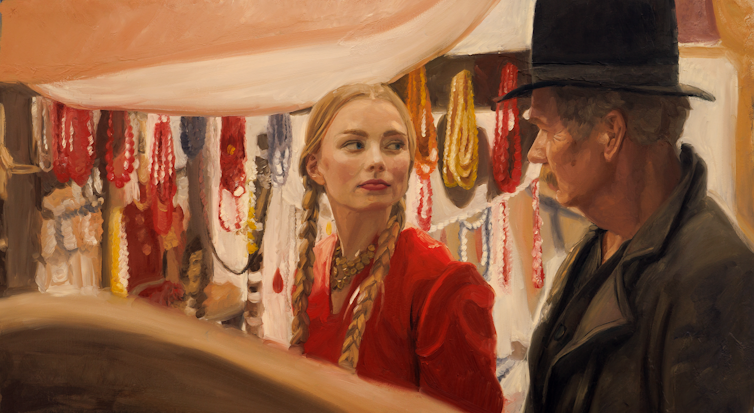The Peasants tells the story of a beautiful young Polish girl, Jagna (Kamila Urzędowska), who was sold into a marriage to the richest man in the village – an older widower named Boryna (Mirosław Baka). The price is high – six acres of Boryna’s best land – but then, as Jagna’s mother knows: “Love comes and goes but land stays.” The girl herself, of course, does not matter and has no say.
Jagna’s story is based on Polish author Władysław Reymont’s novel, The Peasants, published in four volumes between 1904 and 1909. The Peasants focuses on the arduous life of the Polish peasant, but the story it tells is universally familiar. In 1924, Reymont received the Nobel prize in literature for his “great national epic”, which has been a classic of Polish literature ever since.
The inherent ugliness and cruelty of such marital transactions, typical of rigid patriarchal rural communities, do not clash with the film’s visual beauty and its picturesque character. In fact, they accentuate the beauty of the landscape and the colours of changing seasons, following the way Reymont’s novel is divided into four books: Autumn, Winter, Spring and Summer.
But what makes the film even more visually stunning is that each scene has been painstakingly recreated by a team of oil painters and brought together through special effects – giving it a unique quality somewhere between animation and live action. Six frames for every second of live footage were painted by hand.
Just like in the novel, where the seasons govern every aspect of the peasants’ lives, the colours of the film are governed by the seasons, with the gold of autumn transforming to the white of winter.
However, the beauty of nature is systematically contrasted with human mercilessness towards each other, and also to animals. This brutality is emphasised from the first scene, when Boryna calmly slaughters his best cow because it is sick.
Behind the scenes
Creating The Peasants was a laborious process for the filmmakers. It took five years in all, partially slowed down by the COVID pandemic. This labour has resulted in a stunning and convincing visual masterpiece.
All the actors were carefully filmed to catch their facial expressions, sometimes with cameras attached to their shoulders. This is essential in the multiple dance scenes in which the background and the light change every second.
Then, each scene was painted by over 100 painters from Poland, Serbia, Lithuania and Ukraine. Together, they created more than 42,000 oil paintings.
These paintings were used to create each frame of the film. The film’s directors – Dorota Kobiela-Welchman and her husband, Hugh Welchman – are the creators of this method of oil-painted films. Their previous work, Loving Vincent (2017), was a highly successful experimental animated drama about Vincent van Gogh. It took six years and over 62,000 oil paintings in the style of Van Gogh, which were created by 125 artists.
Read more: Old-school painting meets cutting-edge animation: Loving Vincent is a rich visual feast
The powerful beauty of The Peasants comes from the setting of the film against famous Polish and European paintings, many of which have become so intimately known that we subconsciously see the world and its colours through them. Jagna’s beauty and her budding sexuality are highlighted, for example, by presenting her turned face with half-open lips in the same pose and palette as Vermeer’s Girl with a Pearl Earring (1665).
The Welchmans have used paintings by Polish painters who mixed realism with symbolism, such as Józef Chełmoński, Leon Wyczółkowski and Ferdynand Ruszczyc – along with other famous works including Jean-François Millet’s The Gleaners (1857) and Van Gogh’s Noon-Rest from Work (1890).

Jagna is presented as a young girl with artistic flair and – compared with the villagers who believe her to be a dangerous and immoral seductress – unusual kindness.
She takes care of a stork with a broken wing, makes jewellery, and constantly creates delicate paper cutouts of animals, especially birds. Yet, unlike these birds she creates, she does not have any freedom herself.
Fans of Reymont’s novel will be pleased to find the film is highly faithful to its source material. But The Peasants also offers fresh readings of the 100-year-old Polish classic, exploring its themes of power and resistance in ways that will give even his most ardent readers new food for thought.

Looking for something good? Cut through the noise with a carefully curated selection of the latest releases, live events and exhibitions, straight to your inbox every fortnight, on Fridays. Sign up here.

